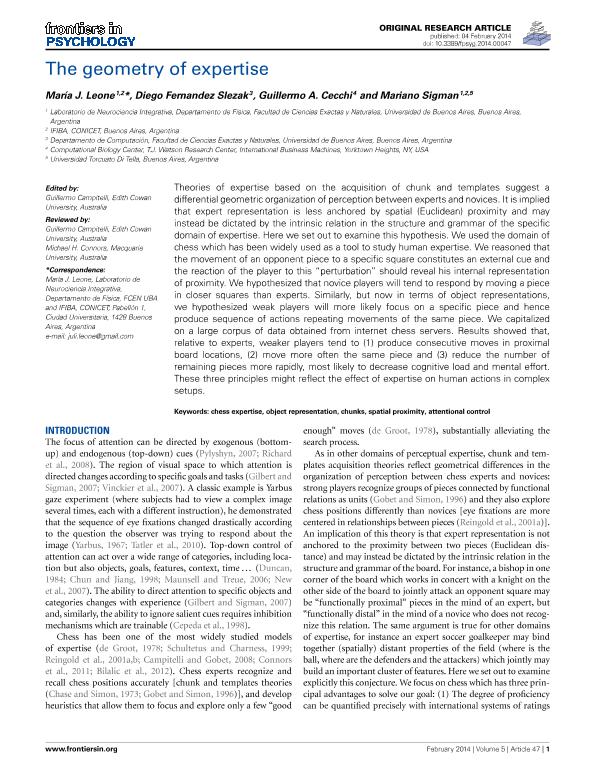Mostrar el registro sencillo del ítem
dc.contributor.author
Leone, Maria Juliana

dc.contributor.author
Fernandez Slezak, Diego

dc.contributor.author
Cecchi, Guillermo Alberto

dc.contributor.author
Sigman, Mariano

dc.date.available
2019-05-27T16:24:19Z
dc.date.issued
2014-02
dc.identifier.citation
Leone, Maria Juliana; Fernandez Slezak, Diego; Cecchi, Guillermo Alberto; Sigman, Mariano; The geometry of expertise; Frontiers Media; Frontiers in Psychology; 5; 2-2014; 1-21
dc.identifier.issn
1664-1078
dc.identifier.uri
http://hdl.handle.net/11336/77189
dc.description.abstract
Theories of expertise based on the acquisition of chunk and templates suggest a differential geometric organization of perception between experts and novices. It is implied that expert representation is less anchored by spatial (Euclidean) proximity and may instead be dictated by the intrinsic relation in the structure and grammar of the specific domain of expertise. Here we set out to examine this hypothesis. We used the domain of chess which has been widely used as a tool to study human expertise. We reasoned that the movement of an opponent piece to a specific square constitutes an external cue and the reaction of the player to this "perturbation" should reveal his internal representation of proximity. We hypothesized that novice players will tend to respond by moving a piece in closer squares than experts. Similarly, but now in terms of object representations, we hypothesized weak players will more likely focus on a specific piece and hence produce sequence of actions repeating movements of the same piece. We capitalized on a large corpus of data obtained from internet chess servers. Results showed that, relative to experts, weaker players tend to (1) produce consecutive moves in proximal board locations, (2) move more often the same piece and (3) reduce the number of remaining pieces more rapidly, most likely to decrease cognitive load and mental effort. These three principles might reflect the effect of expertise on human actions in complex setups. © 2014 Leone, Fernandez Slezak, Cecchi and Sigman.
dc.format
application/pdf
dc.language.iso
eng
dc.publisher
Frontiers Media
dc.rights
info:eu-repo/semantics/openAccess
dc.rights.uri
https://creativecommons.org/licenses/by-nc-sa/2.5/ar/
dc.subject
Attentional Control
dc.subject
Chess Expertise
dc.subject
Chunks
dc.subject
Object Representation
dc.subject
Spatial Proximity
dc.subject.classification
Otras Ciencias Biológicas

dc.subject.classification
Ciencias Biológicas

dc.subject.classification
CIENCIAS NATURALES Y EXACTAS

dc.title
The geometry of expertise
dc.type
info:eu-repo/semantics/article
dc.type
info:ar-repo/semantics/artículo
dc.type
info:eu-repo/semantics/publishedVersion
dc.date.updated
2019-05-23T20:19:58Z
dc.journal.volume
5
dc.journal.pagination
1-21
dc.journal.pais
Suiza

dc.journal.ciudad
Basel
dc.description.fil
Fil: Leone, Maria Juliana. Universidad de Buenos Aires. Facultad de Ciencias Exactas y Naturales. Departamento de Física. Laboratorio de Neurociencia Integrativa; Argentina. Consejo Nacional de Investigaciones Científicas y Técnicas. Oficina de Coordinación Administrativa Ciudad Universitaria. Instituto de Física de Buenos Aires. Universidad de Buenos Aires. Facultad de Ciencias Exactas y Naturales. Instituto de Física de Buenos Aires; Argentina
dc.description.fil
Fil: Fernandez Slezak, Diego. Universidad de Buenos Aires. Facultad de Ciencias Exactas y Naturales. Departamento de Computación; Argentina. Consejo Nacional de Investigaciones Científicas y Técnicas. Oficina de Coordinación Administrativa Ciudad Universitaria. Instituto de Física de Buenos Aires. Universidad de Buenos Aires. Facultad de Ciencias Exactas y Naturales. Instituto de Física de Buenos Aires; Argentina
dc.description.fil
Fil: Cecchi, Guillermo Alberto. Thomas J. Watson Research Center; Estados Unidos
dc.description.fil
Fil: Sigman, Mariano. Consejo Nacional de Investigaciones Científicas y Técnicas. Oficina de Coordinación Administrativa Ciudad Universitaria. Instituto de Física de Buenos Aires. Universidad de Buenos Aires. Facultad de Ciencias Exactas y Naturales. Instituto de Física de Buenos Aires; Argentina. Universidad de Buenos Aires. Facultad de Ciencias Exactas y Naturales. Departamento de Física. Laboratorio de Neurociencia Integrativa; Argentina. Universidad Torcuato Di Tella; Argentina
dc.journal.title
Frontiers in Psychology
dc.relation.alternativeid
info:eu-repo/semantics/altIdentifier/url/http://journal.frontiersin.org/Journal/10.3389/fpsyg.2014.00047/abstract
dc.relation.alternativeid
info:eu-repo/semantics/altIdentifier/doi/http://dx.doi.org/10.3389/fpsyg.2014.00047
Archivos asociados
